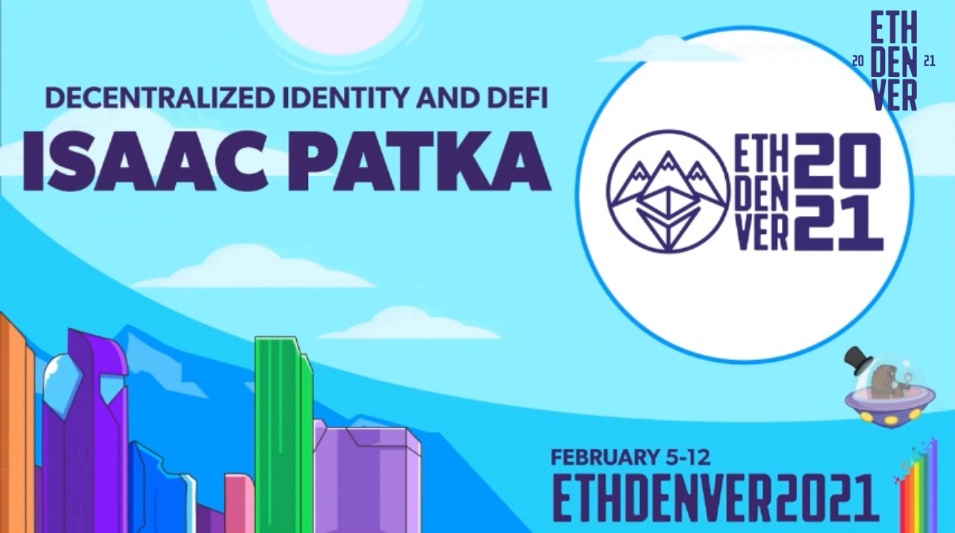How Bloom is Bridging the Gap Between DeFi and Decentralized Identity
Bloom's CTO Isaac Patka recently gave a talk at ETHDenver 2021 in which he discussed the co-evolution of the DeFi and Decentralized Identity spaces; and how Bloom is bridging the gap between them.
Watch the full talk by clicking on this link.

Decentralized Identity & DeFi are Disconnected
While the markets for decentralized finance and decentralized identity are both expanding rapidly with new and novel products, the two are still largely disconnected.
DeFi apps are increasingly built to be interoperable amongst each other mainly due to their adherence to a single common standard, ERC20. This allows tokens to move between projects to contribute liquidity to Automated Market Makers, be used as collateral for loans, or provide much needed liquidity to borrowers in return for interest.
Similarly, decentralized identity products and services are quickly maturing into its own ecosystem, with continued collaboration between service provider members of DIF and a quickly developing standard of interoperability through W3C. And yet despite fast maturing markets in each sector, few solutions exist to bridge the communication and integration between these two worlds.
Decentralized Identity is Chain-Adjacent
The beauty of the decentralized identity space is that it is built on blockchain fundamentals. While the identity record or credential itself is created off-chain, it can rapidly be brought on-chain and converted to a digital identity solution using technologies developed by a number of innovators in the space including Sidetree and Bloom. Existing open-source blockchain wallet technologies already support native distribution of decentralized identities (DID). Sidetree, for example, is a scalable DID protocol that enables interoperability with IPFS and any decentralized ledger system.
Bridging Decentralized Identity with DeFi
While decentralized identity systems can be said to be chain-adjacent, they need an intermediary to help facility the relaying of this chain-adjacent information to on-chain requestors such as DeFi applications. These intermediaries or so-called bridges already exist in many forms and can be leveraged to provide decentralized access to DID systems. Examples include Oracles, which can connect with data vaults to retrieve information specific to an individual user. NFT’s are another example, where unique attributes can be packaged within them and exchanged for specifically tailored services. Because of the rapid innovation that has occurred in the DeFi and larger blockchain space, the technology already exists to facilitate a complete ecosystem of interconnected products starting with digital identity verification to the rendering of decentralized finance products and services.
Decentralized Identity & DeFi are Complimentary
DeFi Has a Trust Problem
Popular DeFi lending apps like Compound and Aave have a trust problem. Because they collect no information on their participants, they are unable to make informed decisions on how much to lend, what interest rate to charge, and for how long the loan should be extended. Instead, they must treat all participants with the same level of risk, and thus require significant sums of collateral, in exchange for loans. This means that borrowers must already possess more than the value of cryptocurrency they are asking to borrow, making DeFi lending impractical for participants who own little to no cryptocurrency.
To compound this issue, regulations in the cryptocurrency space are quickly expanding and evolving. According to the FATF “Travel Rule,” Virtual Asset Service Providers (VASPs) are required to verify the identities of individuals using their products in an effort to curb the financing of terrorism. DeFi platforms are unlikely to successfully skirt these regulations based on the technicality that they are “decentralized.” While most operate in a decentralized manner, they are still subject to regulatory enforcement. For example, Compound has equity investors and therefore must have a base of operations and an entity to which these original equity contracts were signed. This means it can be subject to the same regulatory requirements that are required by traditional financial institutions. Thus, DeFi platforms like Compound are very likely to be required to adhere to Travel Rule regulations, necessitating eventual screening of participants.
Decentralized Identity has an Adjacency Problem
Even with the strides made within the decentralized identity ecosystem, including new use cases in a variety of different industries, their widespread use is still limited. The decentralized identity space is poised to deliver a myriad of novel solutions to the world of distributed ledger applications; but its dependency on decentralized apps that are still finding traction means it may take some time to find adoption.
However, the one blockchain sector that has proven scale and usage is DeFi. It has an immediate need and demand for decentralized identity solutions and is perfectly suited to be paired with such platforms. It’s immediate need from both a consumer demand and regulatory compliance standpoint means that it is an ideal first-mover fit with current DID solutions. Bloom is just one of the many decentralized identity management platforms that offers highly-performant solutions to bridge the gap between DeFi and DID systems. Other examples exist which we will discuss.
How Decentralized Identity is Being Used
Health Data Passports
Currently the International Air Transport Association (IATA) is exploring methods in which travelers can move across borders freely without concern for further COVID spread and transmission. IATA has proposed the use of a Travel Pass which will contain testing information on travelers in a verified and secure way. Travel Pass itself is based on IATA’s OneID, an initiative endorsed by resolution at its 75th Annual General Meeting to help securely facilitate travel through the use of a single identity token. It is one of the first of its kind to retain passenger identity information on a device, specifically managed and permissioned by the traveler, ensuring privacy through a decentralized identity management solution. OneID serves as the base for Travel Pass.
Employment Information
Truu is an example of a platform that facilitates the simplified management of employment information through the use of a decentralized identity management system. It collaborates with regulatory bodies, central National Health Service (UK) organizations and trusts to provide a digital passport for healthcare professionals. It builds a comprehensive record that includes identity information, qualifications, workplace-based assessments, medical licensing, and employment information all as separately verified credentials. Truu enables employers to make fast decisions on employment without the inefficiencies in tracking down records and other documents or managing communications between a variety of different data sources. This is especially helpful in circumstances where rapid medical deployment is necessary such as in pandemic situations where medical professionals are being moved and employed between new job sites in any given day of the week. Credentials are held digitally within a professional’s mobile device ensuring privacy and enabling specific dissemination of information on an as-needed basis. Truu runs on Everynym’s distributed ledger technology and is a founding-member of Sovrin, a nonprofit organization enabling self-sovereign identity on the internet.
Credit, Income, KYC Data
Bloom continues to set the benchmark for how digital identity can be leveraged by decentralized financial institutions. Bloom works by securing an individual’s digital identity information through receipt of verified credentials from an issuing body. From there, it allows an individual to interact with various DeFi platforms that request and require identity information on its users to provide specifically tailored services such as credit facilities or to simply pass KYC checks as required by law. Bloom’s DID platform provides several methods in which third-party applications can access DID data and isn’t specifically limited to DeFi uses cases. It can function wherever DID is needed, and the technology is expandable to support other use cases where personalized information needs to be made sharable but private at the same time.
Building Solutions
Digital identity management systems enable DeFi platforms to perform KYC. However, in the spirit of DeFi, just as cryptocurrencies used to interact with these platforms are held non-custodially, the digital identity data can also be processed in a non-custodial manner. In fact, according to information provided by the original author of KYC legislation, financial institutions need not store a copy of information used to perform KYC, only evidence that such KYC checks have occurred. This means DeFi platforms can maintain the highest levels of security and privacy by reducing risks of “honey pot” hacks, while greatly improving user experience.
DID systems also provide a gateway to unsecured lending. They help transition existing CeFi users on platforms like BlockFi and Celsius over to non-custodial DeFi platforms, enabling the benefits of CeFi without its risks and drawbacks.
The industry is ripe for exploration with new use cases and innovations being rolled out regularly. If there is something you want to build at the intersection of decentralized identity and crypto we’d love to hear from you.
Contact: isaac@bloom.co
Telegram: @IsaacPatka
Github: https://github.com/ipatka
DIF Banking & Finance SIG: https://lists.identity.foundation/g/finance-sig

